Spring — the most favourable time for garden work. During this period, fruit tree grafting begins. There is enough time for the scion to take root, and even if the procedure fails, it can be repeated in early summer.
Learn how to graft an apple tree step by step in spring, following the recommendations of experienced gardeners.
Table of contents
When is the Best Time to Graft an Apple Tree
The most favourable period is spring. Grafting with cuttings begins in March – April. Budding or "eye" grafting is done in April – early May.
The best time is when the buds have not yet opened but sap flow has already started. The procedure is performed on a cool, cloudy day.
Advantages of spring grafting:
- the possibility to repeat the procedure in summer without waiting until next spring if the scions fail to take root;
- correction of tree defects;
- fixing underdeveloped trunks;
- restoring an uneven crown;
- reviving damaged trees;
- developing hybrid and dwarf varieties;
- boosting the plant’s immunity;
- preserving the taste and appearance of the variety.
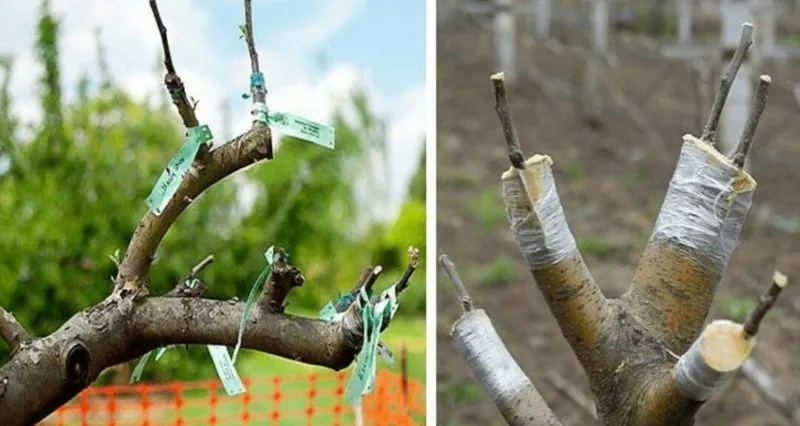
Optimal Time According to the Lunar Calendar
Grafting fruit trees is best done during a waxing Moon. This enhances varietal qualities and improves the tree’s resilience. Gardeners recommend performing the procedure on "fruit days," closer to the full moon, when the Moon is in Aries, Leo, or Taurus. The waxing Moon directs sap and energy into the new shoot, aiding faster establishment.
Grafting calendar for apple trees in 2024:
- March — 1-4, 6, 8, 26, 29;
- April — 2, 5, 7, 24, 25, 30;
- May — 1, 2, 6, 15-17, 27, 29.
Grafting calendar for apple trees in 2025:
- March — 4, 12-14;
- April — 1, 3-5, 8, 9, 13, 14, 19, 25, 26, 28;
- May — 2, 5-7, 12-17, 21, 22, 24-26.
Purpose of Grafting
Apple tree grafting is performed to:
- increase yield;
- replace an old variety with a new one;
- experiment and grow several new varieties on an old rootstock;
- save space in the garden (two varieties can grow on one rootstock);
- cultivate wild apple trees;
- save a tree damaged by rodents;
- improve frost resistance of delicate varieties;
- grow a dwarf apple tree.
How to Prepare the Apple Tree
Experienced gardeners recommend following these basic rules for grafting apple trees:
- Make a diagonal cut 3-4 cm long at the lower part of the cutting, keeping the surface flat.
- The buds on the cutting should face strictly upwards.
- The inner bark of the cutting and rootstock should fit together as tightly as possible.
- The scion should be placed 1-1.5 m above ground level.
- Old branches should be preserved on the rootstock to ensure better nutrition for the root system.
- Trees with a lateral crown should be grafted in stages over 2-3 years.
- The rootstock should be more frost-resistant than the scion.
- Trees with low frost resistance, damaged bark, or wood should not be grafted.
- Avoid inserting the scion too deeply into the cleft, as this may cause rot at the graft site.
- After joining the rootstock and scion, bind the branches before applying grafting wax to prevent it from touching the cuts.
- Practice making clean diagonal cuts on softwood before attempting the real graft.
Choosing the Rootstock
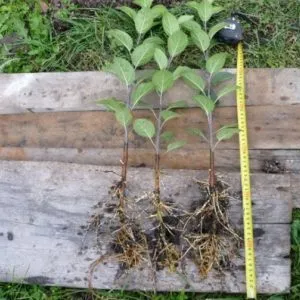
When selecting a rootstock, gardeners recommend considering the ripening and fruiting periods. This is because matching growth phases and rates increase the chances of successful grafting and further development. For example, combining a winter and summer apple variety may lead to nutrient deficiency in the former during ripening, causing partial fruit development and premature drop.
Note. The best rootstock for cultivated apple varieties is seedlings of the Bramley variety.
A high-quality rootstock should have the following traits:
- maturity;
- vigorous growth;
- winter hardiness;
- productivity;
- well-developed root system.
Types of rootstock:
- cultivated;
- wild;
- seed-grown;
- vegetative;
- dwarf;
- vigorous.
Suitable rootstocks include:
- young trees;
- wild shoots;
- fruit-bearing apple trees with mediocre fruit quality;
- damaged trees;
- forest stumps or seedlings grown from wild stock.
Avoid using apple trees older than 10 years as rootstocks. Their sap flow is weakened, and the risk of grafting failure increases significantly.
Preparing Scion Cuttings
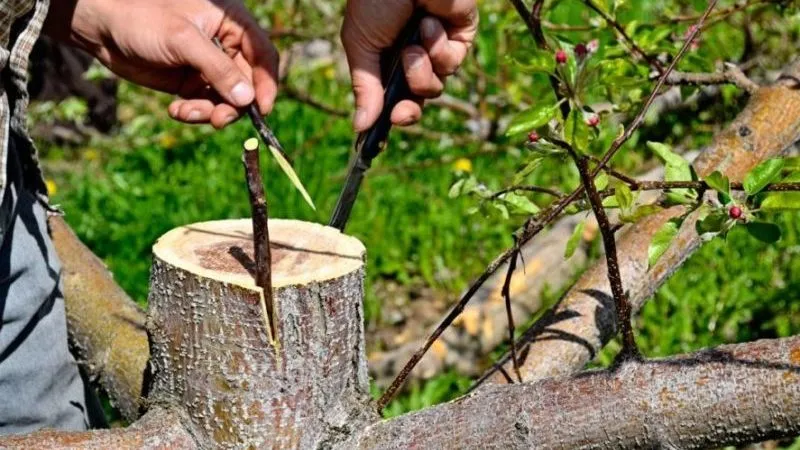
For scions, use one-year-old shoots from healthy apple branches, no longer than 3.5 cm. The lower edge is cut at a 45° angle. The cut length should be three times the diameter of the scion.
How to prepare cuttings:
- Perform the procedure in late October – early November.
- After the first frost, cut long one-year-old shoots with 3-4 buds from the middle part of branches.
- Bundle the material and wrap it in damp cotton cloth or cover it with moist sawdust or sand.
The optimal storage temperature is +2°C. Store cuttings in a cellar, basement, refrigerator, or under snow. If the cuttings start growing, darken, or develop mould, discard them.
If cuttings weren’t prepared in autumn, they can be collected in spring before buds swell. Disinfect tools with surgical spirit or a strong potassium permanganate solution to prevent fungal or bacterial infections.
Remove the branches from storage 48 hours before grafting and let them warm up indoors.
How to Graft an Apple Tree in Spring
There are many grafting methods — choose 2-3 and experiment with each.
Budding Method
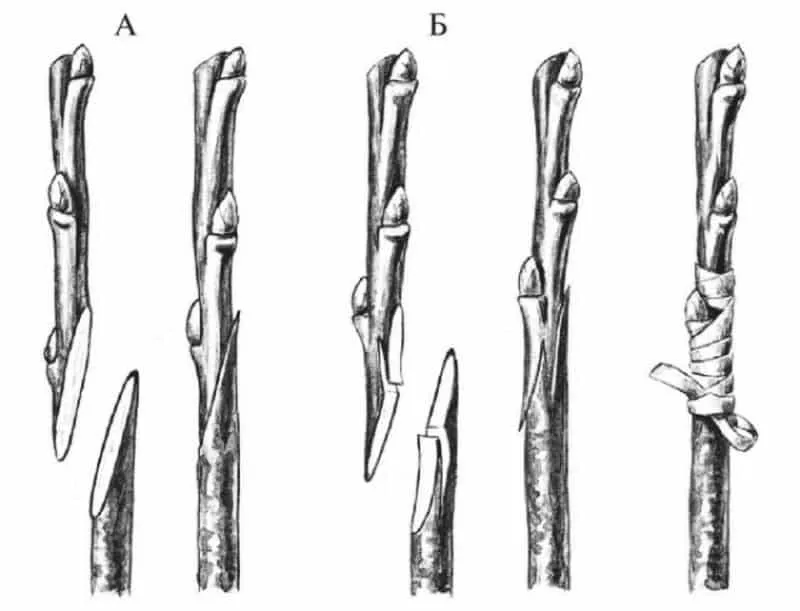
Budding — grafting young apple trees with a sprouting "eye" (bud). Perform the procedure in late March – early April, depending on weather conditions. The air temperature should reach +7…+10°C, and the trees should have their first leaves.
Cut a bud with surrounding tissue from a one-year-old shoot. Insert it into a T-shaped cut on the rootstock trunk.
Cleft Grafting
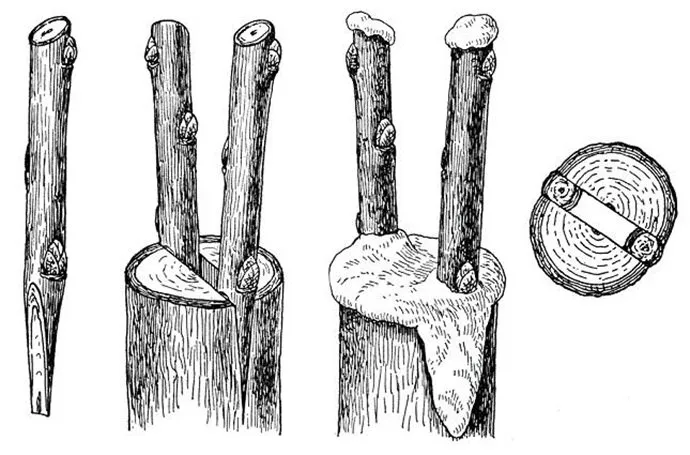
This method is used for regrafting rootstocks. Skeletal branches should be 2-5 cm in diameter, typical for trees aged 3-6 years. Perform the procedure in March – April after the risk of late frosts or in July – August during the second sap flow.
In cleft grafting, a scion cutting is inserted into a split in the rootstock. If the rootstock is twice as thick as the scion, 2-4 scions can be fixed in the split. For four cuttings, make a cross-shaped cut on the rootstock.
Whip-and-Tongue Grafting
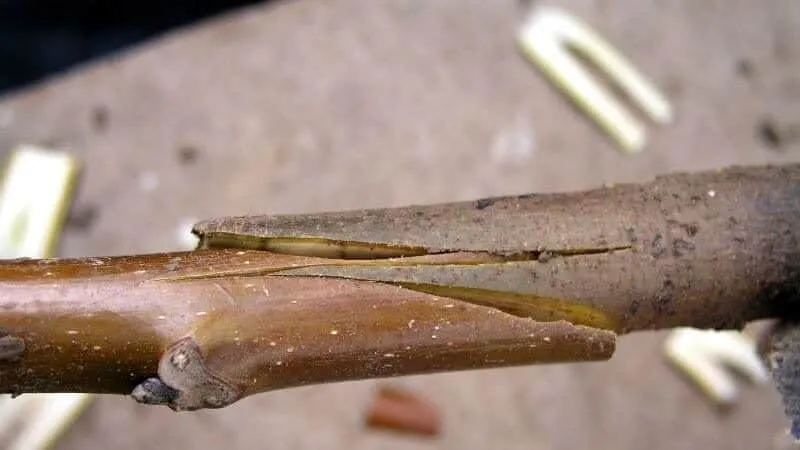
This method is used when the rootstock and scion are of equal thickness. It’s suitable for young apple trees with skeletal branches 2.5-5 cm in diameter.
In whip-and-tongue grafting, the scion and rootstock are joined into a single branch. Success depends on the alignment of the cambium layers. Experienced gardeners recommend the "improved" method if the standard one fails.
In simple whip grafting, diagonal cuts are made on both parts. In the improved method, a 1 cm deep longitudinal cut is added. The scion and rootstock are joined so the cuts interlock.
Important! The grafting procedure should take no longer than 1 minute to prevent the cut from drying out.
Bark Grafting
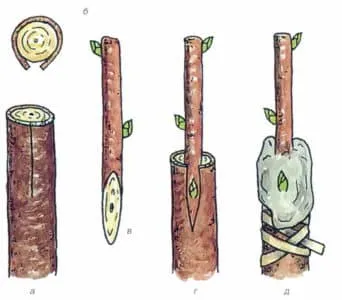
This method is particularly popular due to its high success rate. The scion is cut with a small stub, which is then attached to the branch. The cut must be perfectly straight. The bark on the rootstock is slit vertically and gently pried open. The scion is inserted under the bark, sealed with grafting wax, and wrapped with tape.
Side-Veneer Grafting
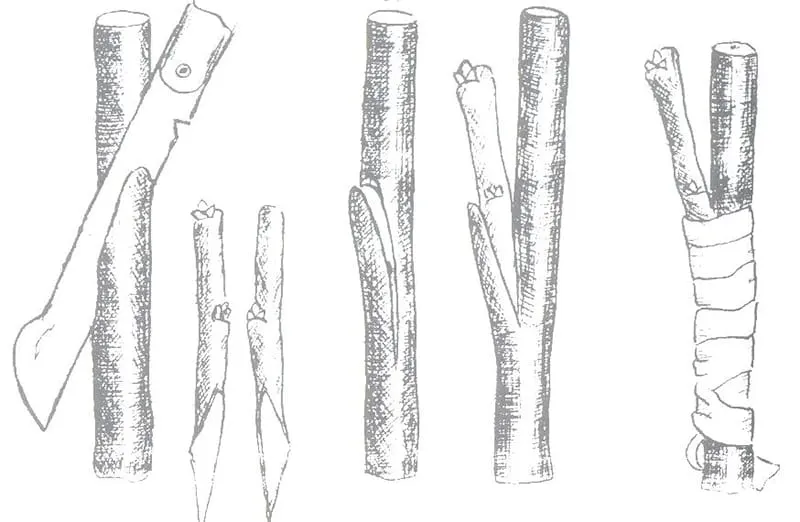
This method resembles cleft grafting, except the split is made on an uncut branch, and the scion is inserted. The main branch remains intact, forming a fork-like joint.
Before side-veneer grafting, make two diagonal cuts on the scion, meeting at the base. A slit is made on the rootstock, pried open, and the scion is inserted until the cambium layers align. Seal with wax and wrap with cloth or tape.
Binding and Aftercare
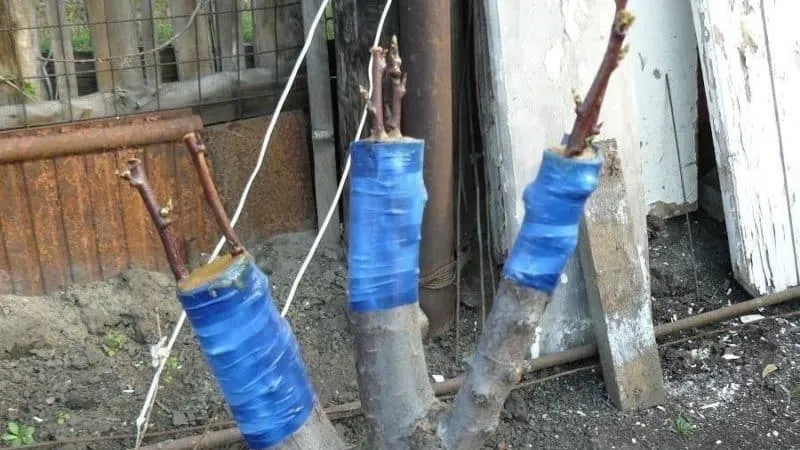
After grafting, seal the joints with grafting wax. For secure fixation, use:
- black tape — enhances warmth at the graft site, promoting tissue regeneration;
- blue tape — stronger than black, providing a firm hold;
- thick polyethylene film — easy to use;
- fabric strips — eco-friendly, absorbs disinfectants well.
Treat the binding with linseed oil to protect against fungi and insects.
Grafting Variations by European Region
In Southern Europe, budding is recommended due to the mild climate with gradual temperature changes. In Central Europe, budding is best done in late July – early August.
Cleft grafting in the south is practised in spring and autumn (September – October). Other methods are equally effective across all regions.
Post-Grafting Care
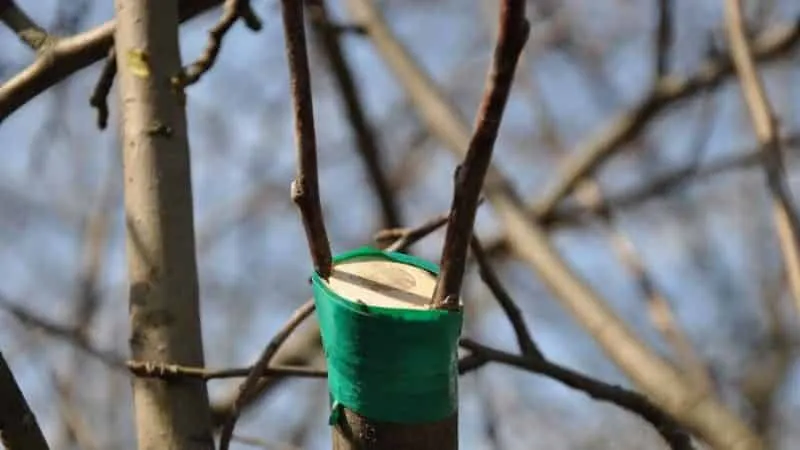
After 10-15 days, check the scion’s viability: inspect the buds and binding. In budding, check if the petiole detaches easily from the shield.
If grafting fails, reapply wax and repeat the procedure in summer.
Loosen the binding in time to avoid damaging the branches. Usually, it’s removed after 2-3 months.
Remove shoots growing below the graft site with a sharp knife. Otherwise, they’ll compete for nutrients. Avoid breaking them off by hand, as this stimulates regrowth.
Shade the graft site to protect it from direct sunlight.
After bud break, perform the first pruning. If multiple shoots emerge from the scion, keep only the strongest (from the top bud). Shorten the lower shoot and cut side shoots back to the skeletal branch.
Tie young shoots when they reach 20-25 cm, repeating at 45 cm. For the first 2-3 years, the graft union remains fragile.
Water generously during droughts and fertilise with organic and mineral supplements. Intensive care speeds up tissue fusion and recovery.
Conclusion
Spring apple tree grafting enhances yield, replaces old varieties, allows multiple varieties on one rootstock, saves space, cultivates wild trees, revives damaged ones, and improves frost resistance. Perform it in March – May, adjusting for regional weather. Popular methods include budding, whip grafting, cleft grafting, bark grafting, and side-veneer grafting. In Southern Europe, budding and cleft grafting are preferred; in Central Europe, budding is done in mid-summer.







